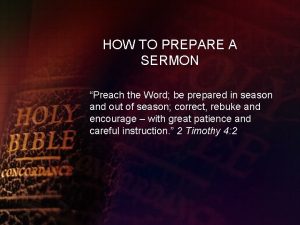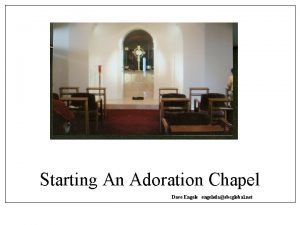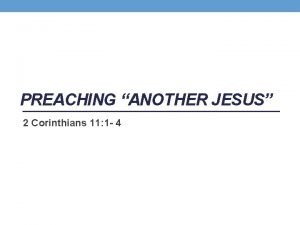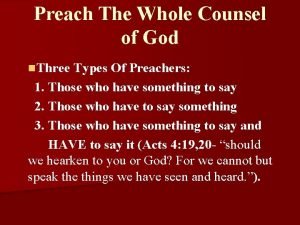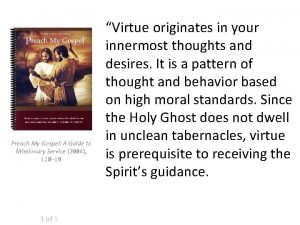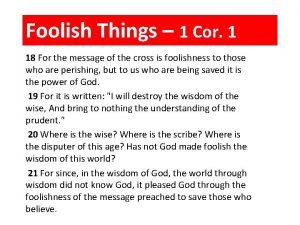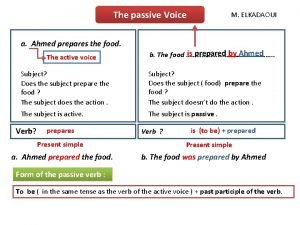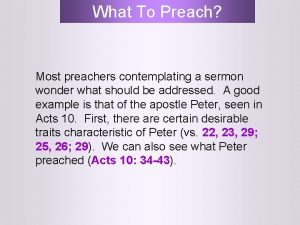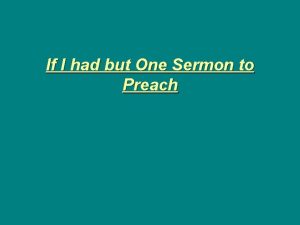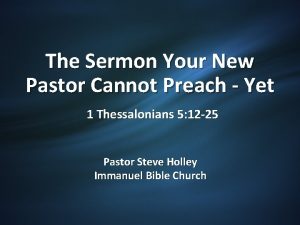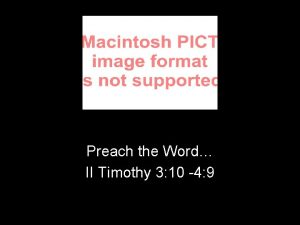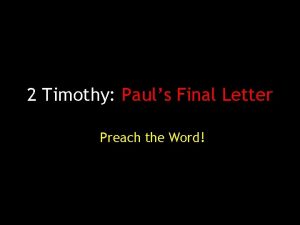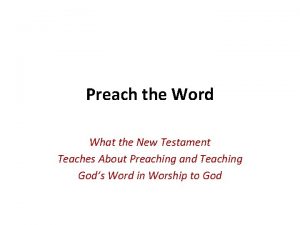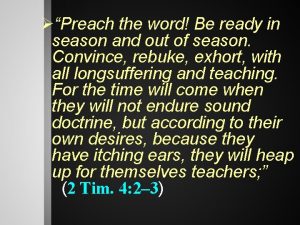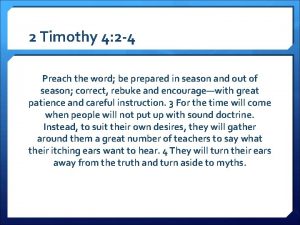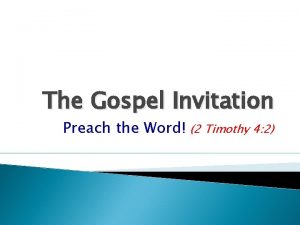HOW TO PREPARE A SERMON Preach the Word
























































- Slides: 56

HOW TO PREPARE A SERMON “Preach the Word; be prepared in season and out of season; correct, rebuke and encourage – with great patience and careful instruction. ” 2 Timothy 4: 2

Consider this: The frontline in spiritual battle today is a battle for the truth.

What is a sermon? • A discourse for the purpose of religious instruction or exhortation • Any serious speech, discourse, or exhortation especially on a moral issue

What is preaching? • The art of preaching is called homiletics • To preach is to proclaim or make known in a sermon, the Gospel/Word of God • To stand in the pulpit and teach is a serious business – you either bring people closer to God or you drive them far from Him, expressed in James 3: 1 • There are gifted preachers and teachers, but anyone willing to be used by God can learn

Objectives of the workshop • To enable a disciple of Christ to effectively preach the Word of God by learning - how to select a theme - how to choose and interpret a text - how to organize a sermon - how sermons are classified and how to construct them - how to prepare an introduction and a conclusion - how to improve the preaching style

How to select a theme A themeless sermon is like a flood which spreads in every direction. A sermon with a theme is like a river flowing within its banks in a certain direction. A train cannot go anywhere no matter how much power the engine has, unless it stays on the track. A sermon may make a great display of steam, but it does not reach home unless it follows its theme.

Difference between theme and topic • A topic • A theme - accurately suggests theme - suited for the bulletin board or newspaper - announced at the beginning before the text is read or immediately afterward - is nearly always longer and more complete than a topic - stated more fully somewhere in the introduction (or implied) - sometimes called the proposition

Two kinds of theme • Rhetorical theme – a subject with its modifiers e. g. “The Blessings of God’s People”, “The Perils of Life’s Journey” • Single words such as “Repentance” or “Faith” are too general and need modifiers to make them specific for themes • Logical theme – consists of a subject and a predicate e. g. “Faith in Christ is the Only Means to Salvation”, Why is Faith in Christ Necessary to Salvation? ” • Suggests divisions as proofs of theme • If in a question form, the divisions are answers to the question

The right theme for each occasion • A sermon must meet the present needs of the people • A doctor does not give all his patients the same medicine, nor does he give medicine at all without diagnosis • A preacher who preaches sermons without a diagnosis of his people’s needs is a ministerial quack and will do people about as much good as a quack doctor

How are the people’s needs discovered? • In prayer (many needs are secret needs) • By listening to members as they share their needs • General condition in the community (epidemic, calamity, moral trend) • Special holidays

Qualities of a sermon theme • Comprehensive – should express the whole aim of the sermon • Biblical – no matter how elaborate the message is, if non-biblical, cannot qualify as a sermon; biblical themes are more authoritative • Dynamic – starts the hearer’s mind thinking to a certain direction, arouses interest and stirs mental activity • Specific – drives specific points that are easy to grasp and apply

How to choose and interpret a text • If it is the business of the preacher to preach the Gospel, if the Gospel is found only in the Bible, if the Bible is the divinely inspired revelation of God’s will; then a sermon ought to be based on a text of Scripture. • Theme first followed by text, or text first followed by theme? • If theme first, exact wording should await text selection for harmony, and text should be chosen that will best support theme • A No No in preaching!: distorting or accommodating the text (out of context verse/ verses forced into theme)

Five rules for selecting a text • Select a real text – a real text is one which is a complete statement, precept, or narrative used with the sense intended by the author. • Texts which are isolated from the context and accommodated to an application foreign to the purpose of the author are not proper texts. • The words of Scripture cease to be Scripture when they are accommodated. • Example: “Shall we go on sinning so that grace may increase? ” is found in the Bible, but when isolated from the context it is contrary to the teaching of the sacred author, and as such, is not Scripture.

Five rules… • Select the great doctrinal and ethical texts of the Bible • Do not fear that people will think of you as naïve or a beginner because you use a familiar text • Texts are familiar and common because the great preachers of every age have used these texts that give comfort and light in dark places

Five rules… • Avoid texts that are known to be interpolations • Portions which have crept into the later manuscripts through scribes’ errors or additions from marginal notes which are not to be found in the oldest and most reliable manuscripts • Also known as spurious texts • Though spurious texts are few, they can be avoided by using several accepted versions of the Bible

Five rules… • Avoid the sayings of uninspired men • Though found in the Bible, they are not proper texts because they lack divine authority • Examples: Job’s three friends, Pharaoh, Satan, Balaam, Pilate, others, whose words are reported, but who are not inspired apostles or prophets

Five rules… • Do not choose texts simply because they are odd or queer • A serious preacher has no time for novelties and curiosities, joyful but not frivolous • Good humour is permissible, but one should not be funny at the expense of the Holy Word • Example: Topic – “Half Baked” Text – “Ephraim is a Cake not Turned”

Eight rules of Biblical interpretation • Hermeneutics – branch of theology that deals with the principles of Biblical exegesis or interpretation • 2 Timothy 2: 15 – “Do your best to present yourself to God as one approved, a workman who does not need to be ashamed and who correctly handles the Word of truth. ”

Rule # 1 – Interpret the text in the light of the context • A verse of Scripture which seems to have one meaning may be seen to mean something else when the context is read. • Example: Colossians 2: 21 – “Do not handle! Do not taste! Do not touch!” seems to be a good prohibition text such as against alcoholism, smoking, etc. But what is the context? Quotation of some negative precepts (legalism) that legalistic teachers were using.

Rule # 2 – Interpret a text in harmony with the teaching of the whole Bible • The Bible does not contradict itself, therefore when a text can have two meanings, the one to be taken is the one in harmony with the teaching of the body of Scripture. • Example: Luke 14: 26 – “If anyone comes to me and does not hate his father and mother, his wife and children, his brothers and sisters – yes, even his own life – he cannot be my disciple. ” • Are we really to hate our near relatives? The great body of Scripture teaches love, therefore the word “hate” must be taken figuratively as a hyperbole. The meaning then is that the disciple must be willing to utterly give up home ties to heed the call to service.

Rule # 3 – The text must be interpreted in harmony with sound, systematic doctrine • Doctrines are formed after consulting the whole Bible’s teaching on a subject. • You cannot establish a doctrine with only a single verse of Scripture that is contrary to the well established Bible doctrine. • The Bible has been subjected to over 2, 000 years of scholarly interpretation so be careful when you interpret a text contrary to the general fundamental consensus (common to cults). • Mag ingat din sa mga Pilosopong Tasyo sa fellowship! These are those who just want to sow controversies in the Church.

Rule # 4 – A text should be taken literally unless it is obviously figurative, or unless a literal interpretation would lead to an absurdity or impossibility • The Bible was written in the common people’s language and for average readers. • A No No in Biblical interpretation! – Unrestricted spiritualizing and allegorizing • In nearly every case where a Bible narrative is allegorized, the forced application is inferior to the real and literal application.

Rule # 5 – If possible, consult the original languages as a help to interpretation • Words of caution: • Do not try to make independent translations of words or passages of the Greek and Hebrew texts unless you have studied the grammar of these languages • Be careful of the source from whom you quote the original words, which could be hearsay. • Unless the situation calls for it, do not carelessly quote passages in Greek or Hebrew before the congregation.

Rule # 6 – Make use of the scholar of other translators • Use several accepted versions of the Bible when trying to interpret a text • It is not sound to claim that only one version or translation of the Bible is correct

Rule # 7 – Consult parallel passages • Scripture is best interpreted by Scripture • Comparing parallel passages can help resolve problems on whether the applications are only local and temporal or are universal and for all times

Rule # 8 – Consult good commentaries of the critical, exegetical type • Devotional commentaries are helpful in suggesting points for elaboration, but seldom give much attention to interpretation. • Writers of good exegetical commentaries are careful Bible scholars conversant with theology and the original languages, but are not infallible. • Do not be a slavish follower of commentaries, but do not either reject their explanations without good reason and careful study.

How to organize a sermon • Not all preachers preach organized sermons; in some cases because the value of organization is not appreciated, in other cases because the methods of organization are not known

Some reasons for organization in the sermon 1. Organization facilitates the preacher’s delivery – A plan makes for a thorough treatment of theme 2. The organized sermon is more pleasing to the hearer – It has more beauty and attractiveness; we cannot expect the congregation to listen attentively to a chaotic sermon 3. The organized sermon is easier to remember – A sermon has value only if it can be remembered

Examples of sermon outlines Example 1 I. God Saves Mankind II. Men Ought to Love One Another III. Faith Is Necessary to Salvation IV. Sin Will Bring Eternal Condemnation V. Lying Is a Great Sin VI. There are Many Signs of Christ’s Soon Return

Examples of sermon outlines Example 2 Text: John 3: 16 I. The Great Lake – God So Loved the World II. The River – That He Gave His Son III. The Pitcher – Whosoever Believeth on Him IV. The Drink – Should Have Everlasting Life Which of the two sermons will most likely be remembered?

Some reasons for organization… 4. The organized sermon can be more easily understood – organization dispels ambiguity 5. Organization increases the effectiveness of the sermon – the Holy Spirit is the largest power in the sermon and the preacher must pray over his sermon and commit it to God. But if man has a part in the sermon, he should make his part as effective as possible

Five Qualities of Good Sermon Organization 1. Unity – One theme prevails throughout all the divisions; if a carpenter wants to drive a nail, he must pound in one place Example: Topic – The Throne of Grace Text – Hebrews 4: 16 I. How We Approach the Throne of Grace with boldness II. Why We Approach the Throne of Grace To obtain mercy and receive help III. When We Approach the Throne of Grace “In the time of need” at all times

Five Qualities… 2. Coherence – the parts should adhere one to the other, in addition to being related to a common theme Compare the following outlines: Outline 1 I. God Is the Author of Faith II. Without Faith a Christian Will Fail III. Faith Is Necessary to Salvation

Five Qualities… Outline 2 Topic: Paul’s Three “I Ams” Text: Romans 1: 14 -16 Theme: Paul’s State of Mind Regarding the Preaching of the Gospel of Christ I. I Am a Debtor to Preach – Vs. 14 II. I Am Not Ashamed to Preach – Vs. 16 III. I Am Ready to Preach – Vs. 15

Five Qualities… 3. Progress – assures that the hearer’s attention will be carried along to the goal; listening to a sermon is like riding a bicycle, as soon as the progress stops, one falls off; hindered by side trips and too much elaboration of one division. Example: Text: Mark 1: 14 -15 I. Jesus Came – His Advent II. Jesus Came Preaching - His Mission III. Jesus Came Preaching Repentance – His Message

Five Qualities… 4. Symmetry – proportionate treatment of each division in the outline; many sermons violate symmetry and progress – too much time spent usually in the introduction and first parts, skipping the later parts for lack of time 5. Climax – a sermon must not only move, it must finally reach an adequate goal indicated by theme; an arrow shot into the air makes progress upward but it does not reach a goal, it falls to the ground when its momentum stops; an arrow shot at a target hits the mark

How sermons are classified 1. Topical sermon – takes from a text only a topic or subject Example: REDEMPTION I. III. IV. The Meaning of Redemption The Necessity of Redemption The Method of Redemption The Results of Redemption

How sermons are classified 2. Textual sermon – takes from the text a subject and the main divisions; more Scriptural in design than topical sermon Example: THE MINISTER: AN EXAMPLE I Timothy 4: 12 “Become an example of believers, in word, in conduct, in love, in faith, in purity. ” I. An Example in Word II. An Example in Conduct III. An Example in Love IV. An Example in Faith V. An Example in Purity

How sermons are classified 3. Expository sermon – takes from the text a subject, main divisions, and all subdivisions; most Scriptural type therefore has more power and authority Example: TEMPTATION James 1: 12 -15 I. The Origin of Temptation, Vs. 13 -14 A. Not from God, Vs. 13 B. From inward desire, Vs. 14

Continued II. The Results of Yielding to Temptation, Vs. 15 A. First sin, Vs. 15 B. Then death, Vs. 15 III. The Reward for Enduring Temptation, Vs. 12 A. Blessedness, Vs. 12 B. A Crown of life, Vs. 12

How to construct a topical sermon 1. By aspects Examples: PRAYER FAITH I. Its Meaning I. What is Faith? II. Its Necessity II. Why is it Needed? III. Its Method III. How is it Received? IV. Its Results IV. What will it Accomplish?

Topical sermon… 2. By proof Example: WE BELIEVE IN THE RESURRECTION OF CHRIST I. The Argument of Faith – the Bible declares it II. The Argument from Testimony – there are many competent witnesses III. The Argument from History – a successful church

Topical sermon… 3. By illustrations Example: THE DISCIPLINARY VALUE OF DELAY I. As seen in the case of Moses II. As seen in the case of Elijah III. As seen in the case of Paul

Topical sermon… 4. By order of materials Example: CHRISTIAN TITHING I. Explain It – what it means II. Prove It – quote Scriptures III. Illustrate It – give examples of benefited tithers IV. Apply It – urge hearers to adopt it

Topical sermon… 5. By analogy Example: THE COURTROOM OF LIFE I. The Judge – God, the Father II. The Accuser – Satan III. The Advocate – Jesus IV. The Verdict – Not Guilty

How to construct a textual sermon 1. Analysis – the easiest and most natural way of dividing a text; ideas are taken in order as they occur in the text Example: THREE DUTIES OF A YOUNG MINISTER I Timothy 4: 13 I. Reading (the Scripture in public) II. Preaching (exhorting the believers) III. Teaching (doctrine)

Textual sermon… 2. Synthesis – Biblical material is from the text, but the total design is invented; order of ideas may be rearranged without distorting the message or meaning; the whole is more than the sum of the parts Example: PERFECT MANHOOD IN CHRIST Ephesians 4: 13 I. Perfect Manhood is the Christian’s Aim II. Perfect Manhood is Seen in Christ III. Perfect Manhood is Achieved by Unity with and Knowledge of Christ

How to construct an expository sermon Varieties of expository sermons: 1. Doctrinal – aim is to expound the doctrinal teaching of a text 2. Ethical – aim is to discover, explain and enforce rules of right Christian conduct 3. Inferential – divisions are derived from inferences drawn from the fact and details of a narrative text 4. Biographical – concentrates on the successes or failures, good or bad characteristics of a Bible character 5. Analogical – divisions are related parts of an analogy 6. Propositional – divisions of the sermon are the arguments in proof of a proposition

Examine the following outline: JUSTIFICATION Romans 5: 1 -9 I. The Need of Justification A. Man is without strength – Vs. 6 B. Man is a sinner – Vs. 8 II. The Provision for Justification A. God’s love - Vs. 8 B. Christ’s death – Vs. 6 III. The Appropriation of Justification – Vs. 1 -2 By Faith IV. The Results of Justification A. Access to grace – Vs. 2 B. Peace with God – Vs. 1 C. Salvation from wrath – Vs. 9 D. Victory in tribulation – Vs. 3 E. Development of character – Vs. 3 -5 1. Patience to experience 2. Experience to hope 3. Hope to shamelessness

How to prepare an introduction and a conclusion Qualities of a good introduction: 1. Striking 2. Clear 3. Unity 4. Brevity 5. Modest 6. Unapologetic 7. Specific

How to find the proper introduction 1. 2. 3. 4. 5. 6. 7. 8. The context of the chosen passage The preceding sermon in a series The special day or occasion The special need of the congregation Personal experience Special importance of the sermon Story or anecdote Current event

Qualities of a good conclusion 1. 2. 3. 4. Clarity Unity Brevity Intensity

Three types of conclusions 1. The lesson conclusion 2. The summary conclusion 3. The appeal type of conclusion

How to improve the preaching style 1. 2. 3. 4. 5. Clear Precise Beautiful Forceful Interesting

Concluding Statements Preaching is the highest of callings and the noblest of arts. A preacher’s work is done to alter the human will and transform the character, with the help of the Holy Spirit. As God’s partner, the preacher’s task is worthy of all the cultivation and perfection which it can be given. Finally, the preacher always gives the glory to God alone. He must decrease, and God increase.

Thank you for your attention and God bless you. To God be the glory!
 Example of a sermon outline
Example of a sermon outline Preach christ and him crucified
Preach christ and him crucified Sample letter of invitation to a pastor to preach
Sample letter of invitation to a pastor to preach Preaching another jesus
Preaching another jesus Preach the whole counsel of god
Preach the whole counsel of god Preach my gospel chapter 3
Preach my gospel chapter 3 There lived a certain man in russian long ago
There lived a certain man in russian long ago We preach christ crucified
We preach christ crucified Hát kết hợp bộ gõ cơ thể
Hát kết hợp bộ gõ cơ thể Bổ thể
Bổ thể Tỉ lệ cơ thể trẻ em
Tỉ lệ cơ thể trẻ em Chó sói
Chó sói Tư thế worm breton
Tư thế worm breton Bài hát chúa yêu trần thế alleluia
Bài hát chúa yêu trần thế alleluia Các môn thể thao bắt đầu bằng tiếng nhảy
Các môn thể thao bắt đầu bằng tiếng nhảy Thế nào là hệ số cao nhất
Thế nào là hệ số cao nhất Các châu lục và đại dương trên thế giới
Các châu lục và đại dương trên thế giới Cong thức tính động năng
Cong thức tính động năng Trời xanh đây là của chúng ta thể thơ
Trời xanh đây là của chúng ta thể thơ Cách giải mật thư tọa độ
Cách giải mật thư tọa độ Phép trừ bù
Phép trừ bù độ dài liên kết
độ dài liên kết Các châu lục và đại dương trên thế giới
Các châu lục và đại dương trên thế giới Thơ thất ngôn tứ tuyệt đường luật
Thơ thất ngôn tứ tuyệt đường luật Quá trình desamine hóa có thể tạo ra
Quá trình desamine hóa có thể tạo ra Một số thể thơ truyền thống
Một số thể thơ truyền thống Cái miệng nó xinh thế chỉ nói điều hay thôi
Cái miệng nó xinh thế chỉ nói điều hay thôi Vẽ hình chiếu vuông góc của vật thể sau
Vẽ hình chiếu vuông góc của vật thể sau Thế nào là sự mỏi cơ
Thế nào là sự mỏi cơ đặc điểm cơ thể của người tối cổ
đặc điểm cơ thể của người tối cổ Thứ tự các dấu thăng giáng ở hóa biểu
Thứ tự các dấu thăng giáng ở hóa biểu Vẽ hình chiếu đứng bằng cạnh của vật thể
Vẽ hình chiếu đứng bằng cạnh của vật thể Phối cảnh
Phối cảnh Thẻ vin
Thẻ vin đại từ thay thế
đại từ thay thế điện thế nghỉ
điện thế nghỉ Tư thế ngồi viết
Tư thế ngồi viết Diễn thế sinh thái là
Diễn thế sinh thái là Các loại đột biến cấu trúc nhiễm sắc thể
Các loại đột biến cấu trúc nhiễm sắc thể Thế nào là số nguyên tố
Thế nào là số nguyên tố Tư thế ngồi viết
Tư thế ngồi viết Lời thề hippocrates
Lời thề hippocrates Thiếu nhi thế giới liên hoan
Thiếu nhi thế giới liên hoan ưu thế lai là gì
ưu thế lai là gì Khi nào hổ con có thể sống độc lập
Khi nào hổ con có thể sống độc lập Khi nào hổ mẹ dạy hổ con săn mồi
Khi nào hổ mẹ dạy hổ con săn mồi Sơ đồ cơ thể người
Sơ đồ cơ thể người Từ ngữ thể hiện lòng nhân hậu
Từ ngữ thể hiện lòng nhân hậu Thế nào là mạng điện lắp đặt kiểu nổi
Thế nào là mạng điện lắp đặt kiểu nổi Prepare thy work without
Prepare thy work without Passive tense chart
Passive tense chart Prepare the following materials
Prepare the following materials How to prepare scheme of work
How to prepare scheme of work Give 5 personal characteristics required by a valet
Give 5 personal characteristics required by a valet Standard solution
Standard solution He prepares all hot and cold dessert.
He prepares all hot and cold dessert.
